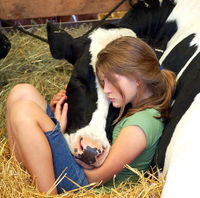
Compassion shared mutually
I’ve already disclosed that I’m an animal lover. And sure, dogs perhaps claim the top spot in my list of animals. I tend to run in circles with other animal lovers, and while we all will admit to having favorites, I find that most people describe themselves very generally – ‘animal’ lover, not specific to any one kind in particular.
But the reality is that we’re not general with our love or compassion at all. Most people are extremely specific. The love and compassion extends to dogs, cats, and sometimes rabbits we keep as pets. Horses often evoke warm and fuzzy feelings, even from a distance. Most of us do enjoy seeing deer or wild turkeys in the fields, and baby ducks in the pond.
But here’s the contradiction – most of the animals listed above are considered inedible. The thought of taking a knife and fork to a tender slice of cat meat probably turns your stomach. But what about the pigs, chickens, cows, and turkeys? That seems completely normal, right? Did they just get on the wrong team when we picked teams and labeled them “edible” and “inedible”? One team gets a life of luxury, pampering, and an endless supply of love and compassion. The other team gets a life of confinement, fear, pain, illness, disease, torture, and as a reward for surviving it all without complaint, they get to be dinner.
As described in “Why We Love Dogs, Eat Pigs, and Wear Cows” by Melanie Joy, Carnism is the invisible belief system, or ideology, that conditions people to eat certain animals. I think conditioning is the key idea here. The decisions we make are largely those that are defined by cultural ‘norms’ that we learn as we grow up and grow accustomed to a culture.
Many people if blindfolded wouldn’t know the difference between eating venison and eating beef. But tell them they ate Bambi or Rudolph after the fact, and they’ll usually be horrified. Why is that? Simply because many of us grew up putting Bambi in the inedible category, having more in common with dogs and cats than pigs and cows. But why?
I’ve heard people claim it’s the intelligence factor, and that we relate better to animals that can think and reason like we can. Here is a good example:
In a Penn State study in 1996-98, researchers tested whether the test subjects could be taught to maneuver a modified joystick to move a cursor on a video monitor. For rewards of M&M’s, Skittles or Reese’s Pieces, the subjects moved the cursor over to a target, then used the cursor to distinguish among scribbles drawn by the researcher’s grandchild.
The subjects were shown one scribble, then a few seconds later shown the same scribble along with a second. They used the joystick and cursor to distinguish between the scribble they had seen before and the one they were seeing for the first time. Sounds like a super cool chimp study, doesn’t it? The subjects were pigs.
Describing another species, Dr. Chris Evans, a psychology professor in Australia explains, “They exist in stable social groups. They can recognize each other by their facial features. They have 24 distinct cries that communicate a wealth of information to one other, including separate alarm calls depending on whether a predator is traveling by land or sea. They are good at solving problems.” Are you still thinking monkeys again? Try chickens.
Dr. Evans says, “Perhaps most persuasive is the chicken’s intriguing ability to understand that an object, when taken away and hidden, nevertheless continues to exist. This is beyond the capacity of small children.”
So if it’s not intelligence, what is it? What allows us to label animals edible vs. inedible? I haven’t come up with a good answer yet. So I made up my own mind. Going against the cultural ‘norm’, I now label all animals as inedible. And yes, the thought of slicing into the filet mignon I once loved is now as appetizing as filet o’ my dog. And that is precisely why I don’t miss eating meat.

Leave a Reply